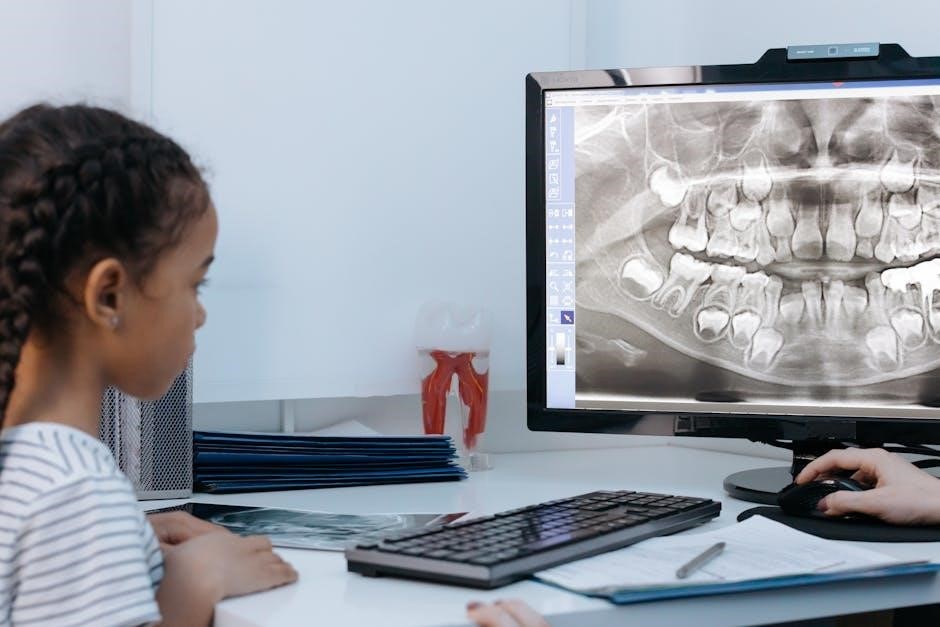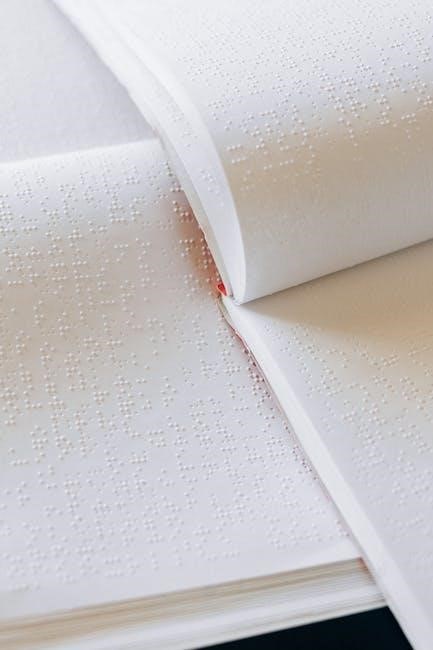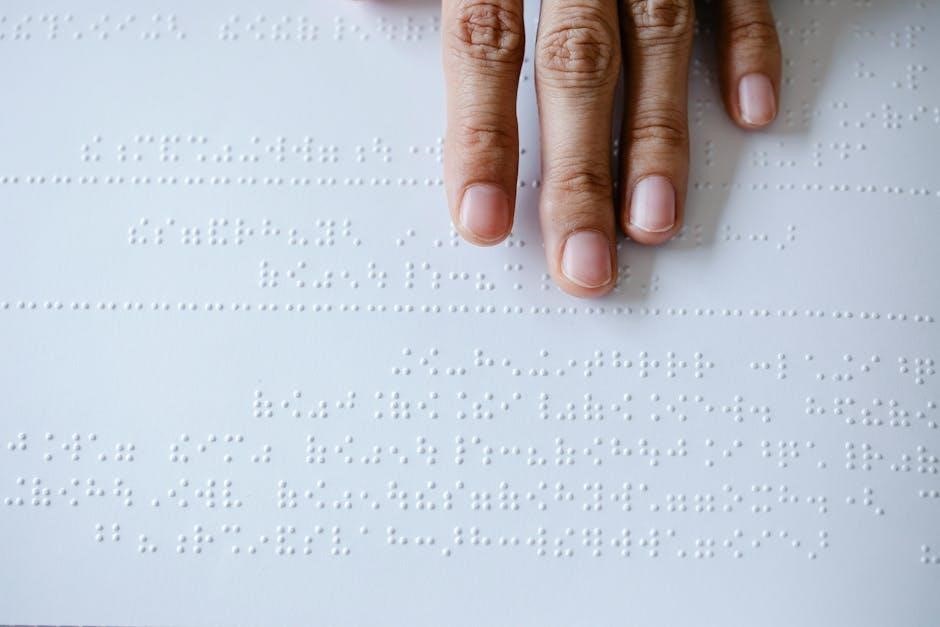eyesight disabled check manual
Eyesight Disability Check Manual: A Comprehensive Guide
This manual offers guidance on assessing eyesight disabilities, including functional vision assessments and visual field techniques. It addresses adaptations for children with visual impairments and available resources. This guide also covers troubleshooting eyesight system issues in vehicles and Social Security disability benefits.

The eyesight disability assessment is a critical process for identifying and evaluating visual impairments that may affect an individual’s ability to perform daily activities. This assessment considers both visual function and functional vision, utilizing various methods to gather information about the learner in functional, developmental, and academic areas. It helps determine the severity of the impairment and its impact on development, education, and overall quality of life.
The assessment process involves specialized training in vision to understand its impact on development, provide appropriate adaptations, interpret results, and make appropriate diagnoses and recommendations. Functional Vision Assessments (FVAs) are essential tools for finding out more information on how someone uses their vision, especially for individuals with learning disabilities. This guide provides an introduction to the assessment process, including core assessment areas for students with visual impairments, that will guide instruction and access to their educational curriculum.

Understanding Visual Impairments and Their Impact
Visual impairments encompass a range of conditions affecting eyesight, from reduced visual acuity to visual field loss, each with unique impacts on an individual’s life. Common visual conditions in children with neuromotor disorders can significantly affect assessment outcomes and require specific adaptations. Understanding these impairments is crucial for providing appropriate support and accommodations, including enlargement of reading material, adjustment of lighting, and raising test materials.
Children with developmental or intellectual disabilities often have higher rates of undetected or untreated vision disorders. The impact of visual impairments on development should be understood to appropriately interpret assessment results. Functional vision evaluations focus on how individuals use their vision daily in school, at home, and in the community. Addressing these impairments early can enhance educational access, improve functional abilities, and promote overall well-being.
Functional Vision Assessment (FVA) Explained
A Functional Vision Assessment (FVA) provides insights into how an individual uses their existing vision to interact with the world around them. It evaluates visual skills in everyday situations, making it essential for individuals with low vision or partial sight. The FVA helps identify specific challenges and strengths related to visual tasks at school, home, and in the community.
Carers, supporters, and learning disability professionals can use FVAs to gather information about a person’s visual abilities. The assessment should be completed by someone who knows the individual well to ensure accurate and relevant insights. FVAs are not typically used for individuals who are totally blind or have light perception only. The FVA is a vital tool in developing personalized interventions and strategies to maximize visual function and improve quality of life. It contributes to a better understanding of how visual impairments affect daily activities and helps tailor support accordingly.
Assessment Methods for Visual Acuity
Visual acuity assessment is a crucial component of any eyesight disability check, determining the clarity of vision at various distances. Traditional methods involve using Snellen charts, where individuals identify letters or symbols of decreasing size. These charts provide a standardized measure of visual acuity, typically expressed as a fraction, such as 20/20.
However, alternative methods are available for individuals who cannot use Snellen charts. These include Teller acuity cards, which use preferential looking techniques to assess visual acuity in infants and non-verbal individuals. Visually Evoked Potentials (VEP) offer an objective measure of visual acuity by recording brain activity in response to visual stimuli.
The future of visual acuity assessment is trending toward more accurate and personalized approaches. Innovations aim to improve early diagnosis of visual impairments and optimize vision correction. These advancements ultimately enhance the quality of life by providing accessible and individualized eye care. Regular and thorough visual acuity assessments are essential for maintaining optimal vision and detecting potential problems early on.
Visual Field Assessment Techniques
Visual field assessment techniques are vital for evaluating the extent of an individual’s peripheral vision. These techniques identify blind spots or constrictions in the visual field, which can significantly impact daily activities. Confrontation visual field testing is a basic method where the examiner compares their visual field to the patient’s, identifying any obvious deficits.
More advanced techniques include automated perimetry, such as the Humphrey visual field test. This test uses a machine to present stimuli at various locations in the visual field, and the patient responds when they see the stimuli. This provides a detailed map of the visual field, detecting subtle losses that may not be apparent with confrontation testing.
For children or individuals with cognitive impairments, alternative methods like kinetic perimetry may be used. This involves moving a target from the periphery towards the center of vision and noting when the patient can see it. Visual field assessment is crucial for diagnosing conditions like glaucoma, stroke, and other neurological disorders that can affect peripheral vision.
Assessment Adaptations for Children with Visual Impairments
Assessing children with visual impairments requires specific adaptations to ensure accurate and meaningful results. Recognizing that vision disorders often go undetected, comprehensive pediatric eye exams are crucial. Adaptations include enlarging reading materials and adjusting the proximity of test materials to the eyes. Lighting adjustments are also essential to optimize visibility and reduce glare.
For children with neuromotor disorders, understanding common visual conditions and their impact on assessment is vital. Specialized training in vision is necessary to understand its influence on development, provide appropriate adaptations, and accurately interpret results. Assessments should be conducted in a comfortable and familiar environment to reduce anxiety and improve cooperation.
Alternative assessment methods may be necessary for children with profound motor or intellectual impairments. The Visual Skills Inventory can be a valuable tool for gathering structured history, especially when carers provide insights. The key is to be flexible and creative, adapting methods to suit the child’s individual needs and abilities, ensuring a comprehensive understanding of their visual capabilities.
Psycho-educational Assessment in Children with Visual Impairments
Psycho-educational assessment in children with visual impairments requires a specialized approach, considering the impact of vision loss on development and learning. These assessments aim to understand the child’s cognitive, academic, and social-emotional functioning, while accounting for visual limitations. It is crucial to be aware of common visual conditions in children with neuromotor disorders and their potential effects on assessment outcomes.
Adaptations to assessment materials are often necessary, such as enlarging reading material, adjusting lighting, and raising test materials closer to the eyes. Understanding the impact of visual impairments on development is essential for interpreting assessment results accurately. Specialized training in vision is critical to provide appropriate adaptations, interpret results, and make informed diagnoses and recommendations.
A comprehensive assessment includes evaluating functional vision, learning media, and identifying priority areas within the expanded core curriculum. Caution should be exercised in interpreting results, considering potential biases introduced by visual impairments. Consulting with vision specialists and utilizing resources like the free online course “Psycho-educational Assessment in Children with Visual Impairments” can enhance competency in this area.
The Role of Visual Skills Inventory

The Visual Skills Inventory plays a crucial role in assessing functional vision, especially in individuals with visual impairments and other disabilities. This inventory provides a structured approach to gathering information about how a person uses their vision in everyday life. It’s particularly useful when caregivers or supporters are unsure about the individual’s visual abilities.
Developed by experts like Gordon Dutton, the Visual Skills Inventory helps identify specific visual skills that may be affected, such as visual attention, visual discrimination, and visual memory. The inventory typically involves a series of questions or tasks designed to assess these skills in various contexts; By understanding a person’s visual strengths and weaknesses, appropriate interventions and supports can be implemented.
For children with profound motor and/or intellectual impairments, the Visual Skills Inventory can be adapted to suit their individual needs and abilities. It serves as a valuable tool for creating a comprehensive understanding of a person’s visual functioning, contributing to improved educational and therapeutic outcomes. The inventory should be administered by someone familiar with the individual to ensure accurate and reliable results.
Developmental Assessment for Individuals with Severe Disabilities (DASH-3)
The Developmental Assessment for Individuals with Severe Disabilities, or DASH-3, is a vital tool in evaluating the developmental progress of individuals with significant physical, sensory, and intellectual disabilities. This criterion-referenced measure identifies specific skill levels across various domains, making it suitable for people of all ages with severe or profound intellectual disability and autism spectrum disorders. DASH-3 offers valuable insight into developmental milestones.
When assessing individuals with visual impairments alongside severe disabilities, DASH-3 becomes even more crucial. It helps determine the impact of visual impairment on other areas of development, such as motor skills, communication, and social interaction. Understanding these interconnected challenges allows for the creation of tailored intervention plans that address the individual’s unique needs. DASH-3 provides a structured approach to identify strengths and areas needing support.
Adaptations may be required to administer DASH-3 effectively to individuals with visual impairments. These adaptations could include modifying materials to enhance visibility, providing tactile cues, or using verbal instructions. Proper administration and interpretation of results require specialized training to account for the influence of visual impairment on performance. DASH-3 results can then inform educational programming.
Social Security Disability Benefits for Visual Impairments
Navigating the Social Security system to obtain disability benefits for visual impairments can be complex. To qualify, your vision impairment must meet specific criteria defined by the Social Security Administration (SSA). Typically, this involves demonstrating that your vision is no better than 20/200 in your better eye with corrective lenses, or that you have a significantly restricted visual field. The SSA assesses visual acuity and field of vision to determine eligibility.
The process begins with submitting a detailed application, including medical records from ophthalmologists, optometrists, and other relevant healthcare providers. These records should document the nature and severity of your visual impairment, including diagnoses, test results (such as visual acuity and visual field tests), and treatment history. The more comprehensive the medical documentation, the stronger your claim will be. Furthermore, any diagnostic testing results must be included.
The SSA’s Disability Determination Services (DDS) will review your application and medical evidence to determine if you meet the criteria for disability benefits. They may request additional information or require you to undergo a consultative examination with their own medical professionals. If your claim is approved, you will receive monthly disability benefits to help offset the financial challenges associated with your visual impairment. Understanding the process is key.
Troubleshooting Eyesight System Issues in Vehicles
Modern vehicles often incorporate advanced driver-assistance systems (ADAS) that rely heavily on eyesight technology, such as cameras and sensors. When these systems malfunction, it can lead to driver frustration and potential safety concerns. This section provides guidance on troubleshooting common issues related to eyesight systems in vehicles. One frequent problem is the “Eyesight Disabled” warning, which can stem from various causes.
Start by ensuring the windshield is clean and free of obstructions, such as dirt, snow, or ice, particularly in the area where the cameras are located. Environmental factors can impede the system’s functionality. If the issue persists, consider whether recent vehicle modifications or repairs might have affected the system. Sometimes, recalibration of the cameras may be necessary, especially after windshield replacement or suspension work. Consult a qualified technician for recalibration services.
Another troubleshooting step involves checking the vehicle’s diagnostic system for error codes. These codes can provide valuable insights into the specific problem affecting the eyesight system. Some issues may require professional attention, such as sensor replacement or software updates. In some cases, the Vehicle Dynamic Control (VDC) system might interact with the eyesight system, causing unexpected behavior. Addressing these issues often requires specialized diagnostic equipment and expertise. Always consult a trusted mechanic!

Resources and Further Information on Visual Impairments
Navigating the world of visual impairments can be challenging, requiring access to reliable resources and support networks. This section provides a compilation of valuable resources for individuals with visual impairments, their families, and professionals working in the field. These resources include organizations that offer information, advocacy, and direct services.
Several national organizations provide comprehensive information on various aspects of visual impairments, including causes, treatments, and assistive technologies. These organizations often have websites with extensive databases of articles, research findings, and practical tips. They may also offer toll-free helplines where individuals can speak with trained professionals who can answer their questions and provide guidance. Local support groups can also be invaluable, offering a sense of community and opportunities to connect with others facing similar challenges.
Furthermore, numerous online courses and training programs are available for professionals seeking to enhance their knowledge and skills in working with individuals with visual impairments. These courses cover a wide range of topics, including assessment techniques, intervention strategies, and assistive technology applications. Additionally, government agencies and research institutions often publish reports and guidelines related to visual impairments, providing valuable insights into current trends and best practices. Consulting with specialists can ensure the most appropriate and tailored support.
